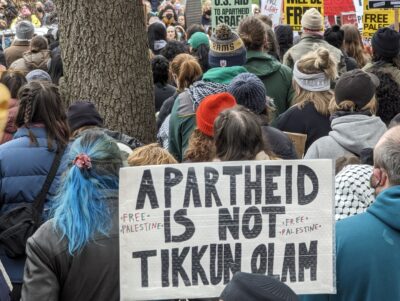 Ceramic bowl–Mohammad Said Kalash (photo: Ilan Amihal)
Ceramic bowl–Mohammad Said Kalash (photo: Ilan Amihal)Seattle’s JTNews brings the welcome news that Offering Reconciliation (link currently not working), an exhibit of ceramic bowls by “Israeli and Palestinian artists representing their longing for peace and an end to the conflict in the region” will come to the Bellevue Arts Museum from June 7-August 19th. I’m looking right now at a newspaper ad for the exhibit and the bowls look ravishing, which is perhaps a strange thing to say about art dealing with such enormous tragedy. But what is wonderful about these bowls is that their colors and vividness express a hopefulness that can never be completely extinguished no matter how badly things go in the region.
The Art Museum site also talks about the artistic vision of the show:
In its conception, the bowl represents the connection between art and life, bringing to mind the act of serving an offering or preparing a feast to gather people together. Once Offering Reconciliation reaches its final destination, the bowls will be sold and all revenues will be used to finance the ongoing educational activities in Israeli and Palestinian schools with the goal of educating the youngest generations to bring peace to the region.
Another delightful element of this tour is that it was organized by the Parent’s Circle, one of the most impressive of all the Israeli-Palestinian dialogue groups. It consists of parents of Israelis and Palestinians whose children have been murdered either in terror attacks or military action. If any Israeli group deserves a Nobel Prize it is this one.
Offering Reconciliation is on a U.S. tour (link currently broken). Unfortunately, the portion of the Parent’s Circle website devoted to the exhibition seems to be not working so I can’t tell you where else it will be touring. But check your local Jewish newspaper.
The Bellevue Arts Museum is also currently hosting Women’s Tales: Four Leading Israeli Jewelers, an interesting-looking exhibit, until June 17th.






Hadassah Magazine is going to be reviewinig this exhibit. Can you send me jpegs, 300 dpi, of some of the images. Send to zshluker at aol.com and ncrain at hadassah.org.
If you cannot help me, please let me know who I should contact. Thank you.
Zelda Shluker
Managing Editor,
Hadassah Magazine
212-451-6288
I appreciate your assistance.
kalash is a tribe in hindukush mountains i do not understand the meaning of this word kalashas mentioned in your remarkable work of art ,
in sansikret it means pure or ashes later on tamils and other suncontinent tribes use it to name a small pitcher or a pot with neck containing ashes ,of some holy significance .
i am an artist ingaged since 1971 with the tribe kalash plus we are always learning as new things when people use or write about some words related to kalash certainly this is a good feeling that some one is writing clearyfying a word KALASH .
the first time Kalash became famous in the west was due to two books kafiristan by a persian writer and kafirs of the hindukush By Robertson meuseums of mankind all over the world are full of kalash tribe artifacts and recently the greek government has built a museum in the kalash valley with some good people who work as ngo s .i wish to thank them too for this giant task
i have been recently given a chance by Mr Ghwelker on you tube with three movies which can be seen at you tube ,kalash a homage
Kind regards to your viewer and readers ,
m.bugi
M. Bugi: Thanks for writing. I believe the name of the artist who created the bowl pictured is Mohammed Said Kalash. I don’t know more about him or the origin of his name I’m sorry to say. The information you provided about Kalash sounds very interesting. This YouTube video makes them appear quite fascinating & is well worth watching.